Truman, Eisenhower and the Endless Pursuit of UFOs
Published June 30th, 2022 at 6:00 AM
Above image credit: A sign directs travelers to the start of the “1947 UFO Crash Site Tours” in Roswell, New Mexico, on June 10, 1997. In Roswell, locals don’t argue anymore about whether a space ship crashed nearby. They argue about whose ranch it landed on. Barring a major revelation between now and July 1, 2022, Roswell will mark the 75th anniversary of the alleged 1947 UFO crash with the debate over what occurred here far from settled. (AP Photo | Eric Draper, File)
It was 1954 and he was just back from the Korean War, sitting at Kansas City’s Muehlebach Hotel, having lunch with the former president of the United States.
Of all the questions he might have asked Harry Truman, young James A. Van Sant – son of Truman friend and Missouri banker Thomas Van Sant – asked the former president about recent sightings of apparent unidentified aircraft.
After all, Truman had been president in July 1952, when air traffic controllers at Washington’s National Airport had reported suspicious blips on their radar screens, and a commercial air pilot then aloft confirmed seeing several bright lights streaking across the sky.
Two military jets scrambled to investigate.
A week later, the same scenario repeated itself. It was news across the country.
“JETS CHASE D.C. SKY GHOSTS,” read the front-page headline in the New York Daily News.
“SAUCERS SWARM OVER CAPITAL,” read the front-page headline in the Cedar Rapids (Iowa) Gazette.
A U.S. Air Force officer, during a subsequent press conference, suggested that a temperature inversion during the hot Washington summer may have resulted in radar signals mistakenly displaying ground objects as appearing in the sky.
Two years later, Van Sant asked Truman about it.
At the time – and today, 68 years later – he found the former president’s response awkward and off-key.
“Nothing there,” Truman snapped at Van Sant.
What Van Sant had thought was a casual question had prompted what he considered a brusque and out-of-proportion response.
“I got the impression that it was not a spontaneous comment,” Van Sant, today 91 and retired in Santa Fe, New Mexico, said recently.
“It was like he was like an actor saying a line in a play. It was a little studied – which of course, tells us that maybe Truman knew more than he was saying.
“It was a very vivid experience.”
This summer is the 75th anniversary of the July 1947 Roswell, New Mexico, alien conspiracy incident. Despite being debunked in the 1990s, the alleged incident involving space wreckage and alien corpses continues to draw visitors to Roswell for its annual UFO Festival, scheduled to begin on July 1.
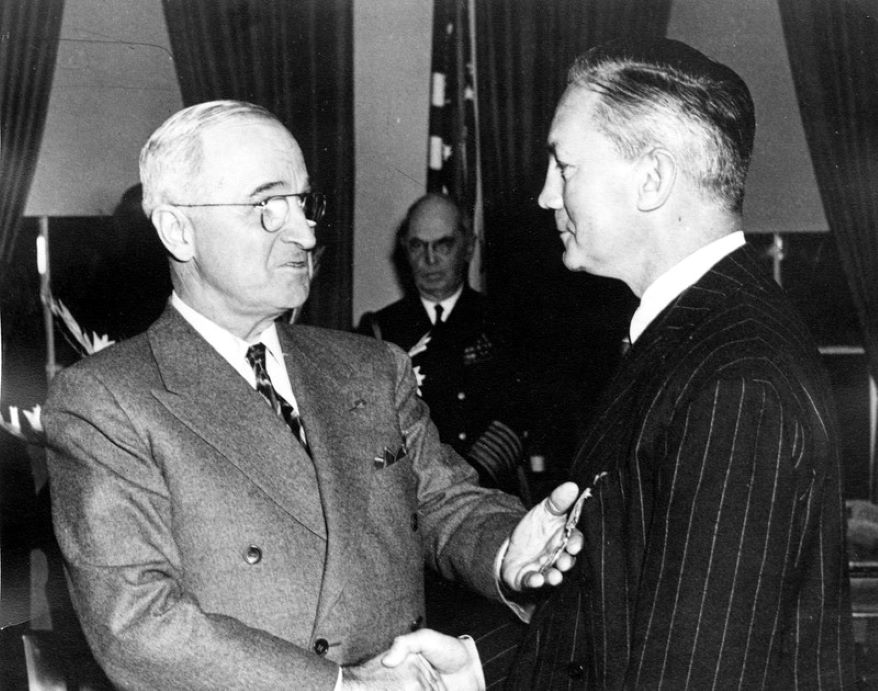
Civilian investigators of unidentified flying objects now are reading the room and sensing a lower level of the ridicule so routinely generated by the topic in the past.
A “Preliminary Assessment” from the Office of the Director of National Intelligence, submitted to Congress last summer, represented a watershed event to many so-called ufologists. It detailed 144 incidents or encounters with “unidentified aerial phenomena” dating back to 2004.
Of those, only one could be explained away as a “large, deflating balloon.”
Attention to the topic, routinely showcased in tabloids positioned at the supermarket checkout line, has migrated to more up-market media outlets.
Last August “60 Minutes” featured interviews with two now-retired Navy pilots assigned to the USS Nimitz who described their 2004 encounter with an aircraft which one of them described as looking like “this little white Tic Tac-looking object” some 100 miles southwest of San Diego.
And, following the release of last summer’s “Preliminary Assessment,” The New Yorker magazine felt obliged to summarize it.
“Perhaps no embalmed aliens had been found in a sub-basement at Wright-Patterson Air Force Base, as believers have long speculated,” the article read, “but these findings were hardly trivial.”
Finally, on May 17, two Pentagon representatives appeared before U.S. House subcommittee members during the first open congressional hearing on UFOs in more than 50 years. They declared unidentified aerial phenomena to be a national security issue and worthy of straight-faced inquiry.
Three weeks later the National Aeronautics and Space Administration (NASA) announced it would initiate its own inquiry.
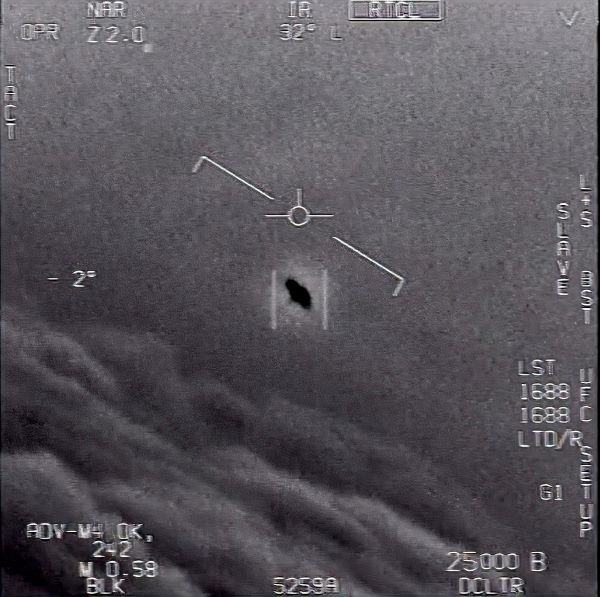
One member of the Kansas City area UFO investigation community, meanwhile, declared the hearing as both encouraging and underwhelming.
“At first I thought it would be the same old same old,” said Nancy DeSousa of Shawnee, assistant Kansas chapter director of the Mutual UFO Network (MUFON), which investigates sightings across the world.
“I was concerned that the government would still be controlling information in a way in which members of the general public would not be able to understand what was going on.”
But now DeSousa wonders whether officials are considering releasing more information – but slowly.
“I think the government will follow a controlled, long-term process in which a little bit of information will be leaked out from time to time, in a precautionary way, as opposed to the usual complete denials,” she said.
“I think the average person on the street would be shocked and horrified if the government came out with all the information it has all at once.”
The federal government’s apparent shift to transparency is one reason why Van Sant decided, two years ago, to write up Truman’s reaction to his flying saucer question and send it to the Truman Library in Independence, where it was duly cataloged.
“I think it’s a topic that isn’t explored and needs to be,” said Van Sant, a former St. Louis area steel company executive who described himself as “a layman and interested member of the public” regarding unidentified flying objects.
“There are just too many of these reports and they are too believable to ignore.”
Not in the Files
One reliable metric for the level of civilian interest in UFOs is the volume of questions directed to archivists at the Harry S. Truman and Dwight D. Eisenhower presidential libraries.
The National Archives facilities in Independence, Missouri. and Abilene, Kansas, are devoted to the preservation of documents generated by the two presidential administrations spanning the years 1945 through 1961 – a golden age of pop culture flying saucer narrative.
Accordingly, both facilities maintain documents relating to UFOs. In 2020, Eisenhower Library archivists posted a PDF entitled “UFOs and Flying Saucers,” which listed the facility’s holdings.
The Truman Library also maintains a collection of UFO-related documents, although several of them include notations that they do not represent official library holdings.
The traffic in UFO-related research visits has been a workplace reality for archivists at the Truman and Eisenhower libraries since the 1980s, when various accounts of the Roswell incident began gaining traction.
That continued through the 1990s with the popularity of the film “Independence Day” and the television series “X Files.”
Among the documents available at the Truman library is an apparent September 1947 memo allegedly signed by Truman, directing Secretary of Defense James Forrestal to pursue “Operation Majestic Twelve,” an alleged government inquiry into the Roswell events.
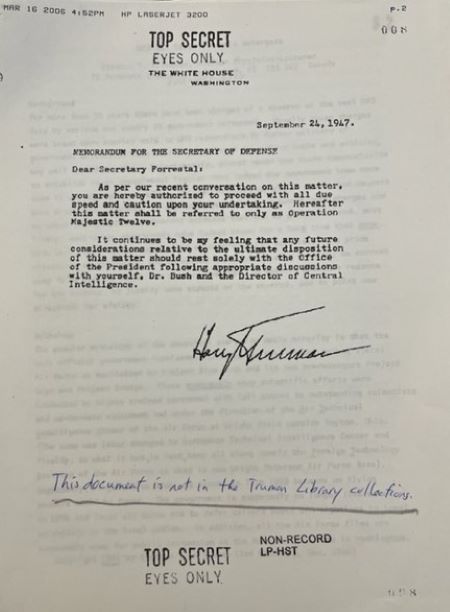
Another purported document is a November 1952 briefing paper allegedly prepared for Eisenhower, elected days before about the same subject.
A copy of the alleged 1952 briefing paper was among documents submitted to the Truman Library in the 1980s. In a 1987 letter to the researcher who supplied it, former Truman Library representative George Curtis said archivists had been unable to find the purported 1952 briefing paper in the library’s files.
An Air Force investigation declared this document bogus. Truman Library archivist Randy Sowell, meanwhile, said the original document still has not been located in their collections.
“We’ve never been able to find that document in President Truman’s papers,” Sowell said.
Nor can staffers find the alleged 1947 memo from Truman to Forrestal in the former president’s files, Sowell added.
In his 1987 letter, Curtis further added that the library’s regulations did not permit them “to pass on the authenticity of documents or handwriting.”
That remains the policy today, Sowell said.
“There’s been much debate going back many years, clashes between various would-be debunkers and would-be proponents of the UFO stories,” said Sowell, adding “we really don’t have the ability to come to a judgment on that.
“We can’t dismiss out-of-hand or confirm stories that have circulated in the press.
“All we can do is report on what we can find and what we can’t find.”
The National Archives and Records Administration, however, aware of the interest in this topic, maintains online resources devoted to it.
And while neither the Truman or Eisenhower library can report any discernible up-tick in researcher requests following the May 17 congressional hearing, UFO-related questions or materials continue to come in.
Truman Library archivists processed the James Van Sant letter, placing it in its Harry S. Truman Collection, which contains miscellaneous documents regarding the 33rd president.
The library also fields occasional questions regarding a 28-second clip found on YouTube, in which Truman appears – just as he did with Van Sant – to dismiss a question about flying saucers.
“Oh yes, we discussed it at every conference that we had with the military and they never were able to make me a concrete report on it,” Truman appears to say during an apparent press conference.
“No, I haven’t anything on the subject … There’s always things like that going on … Flying saucers … We’ve had other things, you know…”
Truman Responds
The words Truman appears to be saying “don’t match any transcript that we have in Mr. Truman’s Public Papers, which cover the public statements of President Truman while he was in office,” according to a statement posted by a Truman Library staff member on History Hub, an online history researchers’ resource.
The video, according to this advisory, could be from a post-presidential press conference, which would explain why Truman Library staff members cannot find a transcript.
But then there’s Dwight Eisenhower’s emergency dentist visit on Feb. 20, 1954. Evidence of that is available.
Debunking Dentist
Officially, President Eisenhower was in Palm Springs, California, on Feb. 20, 1954, golfing and visiting the ranch of a friend.
But there was a two-hour stretch that night when his immediate whereabouts were not known – prompting some to later speculate that Eisenhower, in fact, had made a secret visit to Edwards Air Force Base, either to view alien spacecraft wreckage or conduct a summit meeting with actual living aliens, or something in between.
A version of these stories served as a principal plot device in an “American Horror Story” episode aired last fall.
“Why the UFO people got a hold of this, I don’t know,” said retired Kansas City dentist James Mixson.
“But they did.”
The truth, according to Mixson, had more to do with Eisenhower’s habit of grinding his teeth.
In 1995, Mixson, a scholar of presidential dental history, published “A History of Dwight D. Eisenhower’s Oral Health,” in The Bulletin of the History of Dentistry.
The article detailed how Eisenhower, known for his toothy grin, had a long history of what Mixson described as “parafunctional grinding of his teeth” which had resulted in “heavy lingual abrasion on both maxillary central and left lateral incisors.”
In April 1952, Eisenhower had received a crown on his upper left incisor, which had fractured.
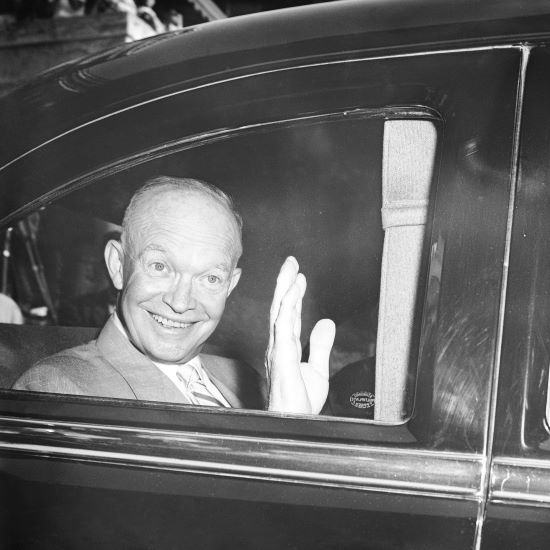
“This tooth,” Mixson wrote, “would have a history of multiple failed restorations, one of which would become the source of a fantastic folklore.”
That July, having by then been named the Republican nominee for president, Eisenhower had that crown replaced.
That crown fractured the following December, and was replaced.
Then, in February 1954 while chewing on a chicken wing in Palm Springs, that crown chipped off.
Eisenhower was taken to a dentist.
The unscheduled evening trip caused confusion. At one point a wire service reported that Eisenhower actually had died of a heart attack, then hastily retracted the report two minutes later.
The following morning Eisenhower’s emergency dental visit was explained to the press. The mundane explanation for the president’s dramatic disappearance apparently struck some as anti-climatic, leading to various alternative explanations.
“Everybody always knows where the president is at all times, but on this particular date they lost track of where President Eisenhower was,” said Mixson, who in 2009 retired as associate professor emeritus at the University of Missouri-Kansas City School of Dentistry.
“I think that was the major thing.”
In 1991, the U.S. Army Surgeon General’s records on Eisenhower’s medical and dental history were opened to researchers. Accordingly, the entry in Eisenhower’s appointment book for Feb. 20, 1954 documented that he left to have the crown repaired between 8 p.m. and 10 p.m.
In reporting this Mixson became a debunker of the alleged secret Eisenhower trip to Edwards Air Force Base.
That was not his original intent. In fact, he was unaware of the legend until Eisenhower Library archivists mentioned it to him.
“I said, ‘What?’ ” Mixson said.
But he doesn’t mind being the debunker.
“I’m kind of flattered by it,” he said.
Mixson sent a copy of his article to John Eisenhower, son of the 34th president. The younger Eisenhower wrote Mixson back, thanking him for the courtesy but adding in a postscript: “Editorially, why all the UFO tripe on p. 97?”
Fitted for Tinfoil
Some UFO researchers, meanwhile, have wondered where Truman was on July 4, 1947 – approximately the same time military personnel allegedly were investigating alien aircraft wreckage near Roswell. In reality, they were recovering a crashed high-altitude balloon which some officials first described as a “flying disc.”
Truman Library staffers have determined that Truman spent the 1947 July Fourth holiday at the Virginia estate of Stanley Woodward, State Department protocol chief.
During a press conference a few days later, a reporter asked Truman if he had seen any flying saucers.
“Only in the newspapers,” Truman said.
That December the U. S. Air Force began collecting and evaluating facts related to unidentified flying objects. Between 1947 and 1969, according to the National Archives, more than 12,000 sightings were reported to the program, entitled “Project Blue Book,” headquartered at Wright-Patterson Air Force Base in Ohio.
Many of the reported sightings were found “explicable by some sort of scientific means,” according to the archives.
Pentagon Perspective
But it wasn’t a topic that interested Truman, according to Ken Hechler, the former president’s special assistant from 1949 through 1953, a member of the U.S. House of Representatives from West Virginia from 1959 through 1977, and a member of the House Committee on Science and Astronautics, which organized a 1968 symposium on UFOs.
“I’m sure that in the four years I worked for Truman, he’d had enough opportunities to bring that subject up if he had thought it was important,” Hechler told The Kansas City Star in 1996.
But he never did, Hechler said.
Nevertheless, the Truman Library maintains, as a courtesy to researchers, copies of “The Roswell Report: Fact vs. Fiction in the New Mexico Desert,” published in 1995, as well as “The Roswell Report: Case Closed,” issued two years later. The crashed balloon of 1947 had been, in fact, part of a secret operation which sought to detect evidence of Soviet nuclear bomb tests.
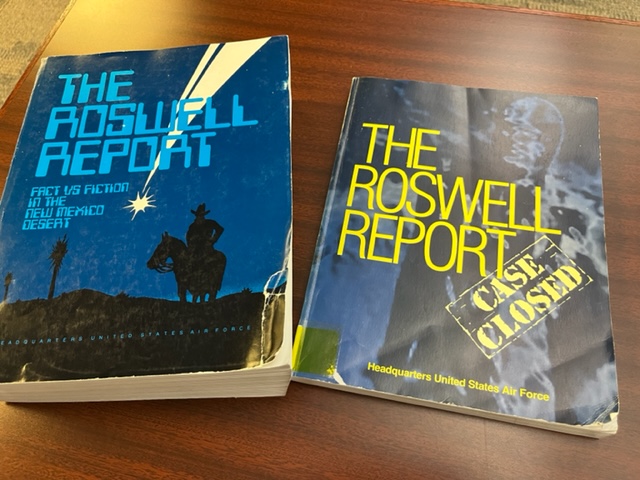
maintains copies of U.S. Air Force reports on the Roswell incidents published in the
1990s. (Brian Burnes | Flatland)
Other presidential libraries retain documents detailing UFO accounts from other chief executives.
The Jimmy Carter Presidential Museum and Library in Atlanta, Georgia, holds a UFO report that Carter, while serving as governor of Georgia, submitted in 1973.
The Gerald R. Ford Presidential Library and Museum in Grand Rapids, Michigan, maintains a 1966 letter sent by Ford, while serving as U.S. House Minority Leader, advocating for a congressional hearing on UFOs after about 40 southern Michigan residents, among them 12 police officers, described seeing unfamiliar aircraft.
After one astrophysicist attributed the sightings to “swamp gas” Ford, apparently resentful at being fitted for tinfoil, described that response as “flippant.”
UFO-associated stigma long has been a reality in Washington.
Former U.S. Sen. William Proxmire of Wisconsin in 1978 presented one of his monthly “Golden Fleece” awards to a proposed NASA program intended to monitor radio signals for evidence of extraterrestrial life. In 1992 NASA initiated a radio program called ”SETI” (Search for Extraterrestrial Intelligence) only to see Congress eliminate the program less than a year later.
The stigma attached to discussing possible unidentified aerial phenomenon among military circles, however, could be fading. The 144 reports listed in the 2021 “Preliminary Assessment” since have increased to about 400, according to the Pentagon representatives who testified in May.
DeSousa, with the Kansas MUFON chapter, believes the reputational risk among civilians also has diminished.
The approximately 50 chapter members used to meet monthly at the Lawrence Public Library. Since the COVID-19 pandemic they no longer do, but DeSousa still meets with anyone wishing to report unusual sightings.
Sometimes, she said, she can offer an earthly explanation for what may at first seem other-worldly events.
“Maybe I can assure someone that what he or she saw the other night had been a meteorite that had been reported that same night,” she said.
If other stories can’t be immediately explained, DeSousa said she serves as a judgment-free listener and files reports with the national organization.
“I am shocked at the higher level of professionals, who never would have called me before because they would have feared – if their stories ever had gotten out – would have jeopardized their reputations,” she said.
Larry Jordan of Kansas City, Kansas, a former assistant Kansas MUFON chapter director, however, isn’t confident that active military members who report unexplained encounters still won’t be marginalized for speaking up.
“My fear is that those who wish to come forward might be forced into retirement,” said Jordan, who added he was speaking as a private citizen and not a representative of the Kansas MUFON chapter.
In the past, active military members who reported possible encounters “would have been met with ridicule, beratement in briefings or interrogations,” said Jordan.
“I do not believe the stigma is disappearing. I do believe what the government says it believes and what it does believe are two different things.”
Our Cosmic Address
At minimum, the May 17 hearing represented a positive effort to not only enhance transparency about government efforts to investigate reports of unexplained aerial phenomena, but also to respect the continuing curiosity of Earth’s inhabitants regarding their “cosmic address,” said Daniel McIntosh, professor and chair of the physics and astronomy department at the University of Missouri-Kansas City.
“There is clearly a strong, persistent interest from the public that is tied to both our imagination and to our desire to understand our place in the universe,” he said.
McIntosh pointed out that one of the Pentagon representatives – Scott Bray, deputy director of U.S. Navy intelligence – had emphasized investigators had not discovered anything “nonterrestrial in origin.”
This was, McIntosh said, “completely unsurprising to me given the physical scale of the cosmos.”
One way to suggest that vastness, McIntosh said, was that anyone attempting to assemble a scale model of the nearest two stars to Earth – the Sun and Alpha Centauri – with the sizes of these two stars represented with two golf balls would have to place one golf ball in Kansas City and the other in Denver to accurately demonstrate the distance between those two on the same physical scale.
Then, McIntosh added, that effort should be accompanied with knowledge that those two stars are just two of more than 200 billion in the Earth’s “home” Milky Way galaxy.
“At these scales, even light speed communication is daunting,” McIntosh said.
“A round-trip, hello-how-are-you conversation would take over eight years between Earth and any ETs at Alpha Centauri.
“Again, we are describing here just our ‘cosmic backyard.’ ’’
McIntosh grew up a science fiction fan, and believes his time viewing “Star Trek” had an influence. “The relationship to ‘The Final Frontier’ no doubt played a role in my pursuit of astronomy as a profession,” he said.
Yet he is not especially captivated with the possibilities of alien encounters with residents of Earth.
“Most scientists, like me, see the frequently publicized claims of ETs, UFOs and alien visitation as essentially harmless examples of pseudoscience,” McIntosh said.
Far more compelling, he added, is the field of astrobiology – the scientific discipline researching the origins of life and searching for life beyond Earth.
Based on modern measurements of the universe, he said, “it is incredibly improbable that Earth is the only home to life in a cosmos containing more than 150 billion galaxies, each an island to millions to billions or even trillions of stars.”
Accordingly, McIntosh added that he “would be hard-pressed to find any astrophysicist who doesn’t believe that life must exist ‘out there’ based simply on mathematical probability arguments.
“We all are just very skeptical that any intelligent ET has visited Earth,” he said.
Flatland contributor Brian Burnes is a Kansas City area writer and author. He is serving as president of the Jackson County Historical Society.
Related Stories


